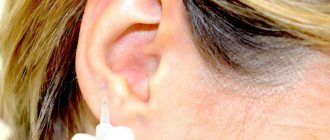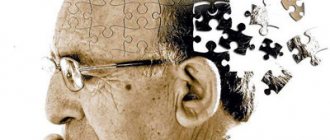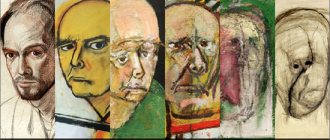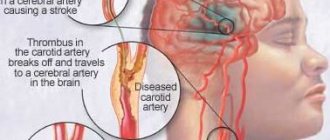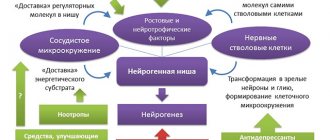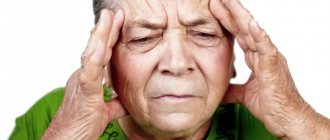There are four main diseases that most often occur in old age and are associated with the activity of the nervous system and in one way or another relate to the mental sphere. Three of them are accompanied by cognitive impairment, amnestic syndrome and personality changes. One mental feature also changes, but it does not reach deep dementia and amnesia.
These diseases are:
- Parkinson's disease;
- Alzheimer's disease;
- Pick's disease;
- atherosclerosis of cerebral vessels.
Older people often suffer from Alzheimer's and Parkinson's disease, so what are the differences between these diseases?
How is Alzheimer's disease different from Parkinson's disease?
The first is caused by damage to the cerebral cortex. This leads to Korsakoff's syndrome, general cognitive impairment, and neuropsychological symptoms. As the disease progresses, severe intellectual impairment occurs. At the final stage, patients retain only fragmentary ideas about their own personality.
Parkinson's disease is caused by the progressive destruction and death of neurons that are responsible for the production of dopamine. This occurs in many parts of the central nervous system. The result is an increased influence of the basal ganglia on the cerebral cortex.
The disease is expressed in the form of four main symptoms:
- tremor;
- hypokinesia;
- muscle rigidity;
- postural instability.
This is accompanied by various vegetative and mental disorders. In principle, the patient may also have amnesia and affective disorders, but this may not be visible.
Alzheimer's and Parkinson's disease, what's the difference? The fact is that they are different. Some patients have decreased intellectual abilities, while others tremble and move with great difficulty.
Alzheimer's disease is a common form of dementia that begins with subtle symptoms
Alzheimer's disease and Parkinson's disease - what is the difference between - Doctor online
Neurological pathologies are often diagnosed in older people.
Such deviations can significantly worsen the quality of life, since they affect higher nervous activity and affect the elementary functions of the body.
The mechanism of development of various diseases of this nature is not the same and is determined by etiological factors and processes occurring in the brain.
People often confuse the symptoms and manifestations of various neurological and neurodegenerative diseases. It is important to know the difference between Parkinson's disease and Alzheimer's disease in order to promptly provide the necessary assistance to a person with a particular problem.
Pick's disease and Alzheimer's disease: differences
Alzheimer's and Pick's diseases have a more common nature. Both of them entail dementia, which is associated with atrophy. The cause of Pick's disease is destruction and atrophy of the cerebral cortex, which primarily affects the frontal and temporal lobes. In Alzheimer's disease, there is a loss of neurons and synaptic connections in the cerebral cortex and certain subcortical areas. Atrophy of the affected areas is more widespread in the temporal and parietal lobes, areas of the frontal cortex and cingulate gyrus.
Worth seeing: Schizoid personality disorder
In Alzheimer's disease, personality changes become noticeable only in the final stage. Amnesia and amnestic aphasia become noticeable from the very beginning. Patients admit their mistakes if they make them. Criticism is lost only when the most severe form of dementia occurs. Dysarthria and logoclonia are present in speech, and perseverations are possible.
With Pick's disease, the personality changes immediately. And always in a negative way. People turn from kind, sympathetic and punctual to embittered, suspicious and disdainful of accuracy. At the beginning of pathogenesis, memory changes are almost not noticeable. The criticism disappears immediately. People can retain acquired skills for a long time, whereas in Alzheimer's disease apraxia occurs at an early stage. The speech of patients with Pick syndrome is standing. They can be verbose, but it is noticeable that there is difficulty finding words.
Alzheimer's disease and Pick's disease are not curable in the full sense of therapy. However, in all cases it is possible to use methods that can significantly improve the general condition of patients. The same can be said about Parkinson's disease. In the case of parkinsonism, medications are used to improve motor functions. These are levodopa, dopamine receptor agonists and MAO-B inhibitors.
Pick's disease is another progressive disease of the human central nervous system, characterized by atrophy of the cerebral cortex.
Clinical picture of Alzheimer's disease
The most typical onset is between 45 and 65 years of age, although earlier or later onset is also possible. There are three main stages of development of the disease: initial, moderate, severe dementia (dementia).
Each of them has its own characteristics. The initial stage is characterized by the appearance of the first signs of impaired memory and thinking abilities: forgetfulness, slight changes in social activity and mental activity. During this period, patients can independently compensate for the defects that appear.
In the stage of moderate changes, a person finds it difficult to navigate in time and place, and a more obvious deterioration in memory appears, especially for events of the present time. Memory loss is characterized by a pathological shift in the focus of attention to the past, its revival. Among the mental defects, difficulties predominate: generalizations, judgments, comparisons.
Causes
No one can name the true causes of Parkinson's and Alzheimer's diseases. The human central nervous system and brain are not yet sufficiently studied for this. After many years of research, today scientists can only name the probable causes of these diseases:
- infections that affect brain cells and neurons;
- Environmental issues;
- various injuries can also be provocateurs of diseases;
- disturbances in neuronal activity;
- problems in the blood supply to the brain;
- genetic predisposition;
- constant consumption of milk in large quantities.
- uncontrolled and long-term use of medications that affect the central nervous system.
None of the above reasons has any concrete evidence. Despite this, experts are convinced that this list is directly related to disorders and complications of the central nervous system and, as a consequence, to the occurrence of diseases. Many scientists also believe that these ailments can be provoked not by one, but by a combination of several of the above factors.
What are the similarities and differences between ailments?
At the initial stage of development of diseases, it is difficult to find their differences. They have absolutely similar symptoms: the appearance of headaches and dizziness, problems with coordination of movements and memory impairment. Only the consequences of the illnesses are different. More precisely, Parkinson's and Alzheimer's diseases differ in the results of destruction of brain cells that are responsible for one or another type of human activity.
With Parkinson's disease, the patient loses physical abilities. But Alzheimer's disease takes away memory, forcing the patient to withdraw more and more into himself every day, losing interest in what is happening, forgetting relatives and withdrawing from society.
The initial symptoms of the diseases are very similar to each other. There is one more property that unites them - medicine is still unable to cure them. Even the most expensive and effective methods of treatment, unfortunately, only lead to remission, which means that a panacea for them has not yet been found.
Overview of Parkinson's Disease
In typical cases, it is inherited as an autosomal dominant trait. The incidence rate increases with increasing life expectancy. Elderly people are most susceptible. The risk of developing pathology does not follow any gender, national or social patterns.
The disease develops in adulthood or old age (between 50-60 years). Only in 1/10 cases does the onset occur before the age of 40 years. Diagnosis is usually simple, and the conclusion is made during the first examination by a doctor. This is how pathologies differ from each other: dementia is quite difficult to recognize at the initial stage.
The criterion for diagnosis is the presence of at least two of the listed symptoms in the patient. Inability to maintain a posture or balance when changing a posture, which is called postural instability. Currently regarded as the leading clinical sign. Patients often cannot maintain balance and fall.
Hypokinesia - a decrease in the amount of motor activity - is expressed in a decrease in the pace and number of movements. From the outside, this manifests itself in the form of a clear impoverishment of facial expressions and gestures.
Patients complain of weakness and fatigue. Late stages of the disease are characterized by difficulty getting out of bed after a night's rest, as well as the inability to easily change body position during sleep.
An objective examination determines resistance to passive movements. Often, increased tone is accompanied by pain, which forces patients to seek help from specialists.
Involuntary rhythmic movements of the limbs and torso - tremor. It is not observed in 100% of cases, it is a consequence of contraction of muscles opposite in direction (the frequency is on average 6 movements per second).
In addition to the above criteria, there are additional signs. These include:
- stooping, slow gait;
- decrease in the amplitude of arm movement when walking;
- difficulty in starting a movement or, if necessary, overcoming an obstacle;
- change in handwriting to small and illegible;
- intonationally monotonous speech;
- blinking slower;
- failure in the swallowing process.
Patients may also complain of changes in the functioning of internal organs: constipation, orthostatic hypotension, frequent urge to urinate.
Mental disorders in patients are varied and manifest themselves in the form of lack of activity, initiative, depression (in 50% of patients), tearfulness, and narrowing of their horizons.
Recently, Siberian geneticists began large clinical studies on volunteers to prevent Alzheimer's disease. You can read about this in “MG” No. 47 dated June 24, 2011. We are talking about the Research Institute of Medical Genetics of the Siberian Branch of the Russian Academy of Medical Sciences in Tomsk, where the preparatory stage of an international study has just completed to study the possibility of preventing this terrible disease, which, in addition to human tragedies, also causes economic damage to the global economy of $604 billion annually.
40 years apart
We deliberately combined two diseases - Parkinson's and Alzheimer's, which not so long ago were considered different. But recent research has confirmed that both diseases have a common molecular basis. The scientific world calls this discovery amazing and unexpected, although such assumptions, as they say, have long been in the air.
But first, about the scientists who discovered these diseases. They could never meet, much less hug each other. The Englishman James Parkinson was born in 1755 and died at the age of 69 (the German Alois Alzheimer was born 40 years later). 7 years before his death, Parkinson was the first to describe the then so-called shaking palsy, a disease of the central nervous system. Moreover, it is interesting that he studied these symptoms not within the walls of hospitals, but in the London slums, “chasing” old women and old men, as if trying to walk in two opposite directions at once, while shaking their whole body from shaking (tremor). This similar state is known to everyone after a good feast (not excluding the author of this article).
German psychiatrist and neurologist Alois Alzheimer was born in 1864 and died at the age of only 51. A lover of feasts, a fan of women, a merry fellow, a joker and the soul of all companies, he immortalized his name by studying and describing the so-called senile dementia (senile dementia), more precisely, the fundamental difference between dementia of vascular and neurodegenerative origin. His colleague, the German psychiatrist Emil Kraepelin, later named this type of senile dementia after Alzheimer's.
In addition, Alois Alzheimer, at the age of 31, headed the research institute and published a 6-volume work, “Histological and histopathological studies of the gray matter of the brain.” Surely he was familiar with the main work of James Parkinson. Perhaps even saw some similarities.
Who did we know?
According to experts, Hitler suffered from pronounced parkinsonism. Mao Zedong, Yasser Arafat, General Franco, Salvador Dali, Andrei Voznesensky, etc. John Paul II, Ronald Reagan, Margaret Thatcher, Annie Girardot, Harold Wilson, and now, it seems, the still living Mohammed Ali, clearly “looked” in the direction of Alzheimer’s...
However, Gabriel García Márquez best described this illness in an ironic manner in his novel “One Hundred Years of Solitude,” although approximately. This is when the inhabitants of a Colombian village lost their memory and were forced to write notes of this kind: “This is a cow, it must be milked every day.” By the way, it is recommended to apply almost similar labels to various objects in the house where a patient with this disease lives. There are many other works in which characters with incredible persistence try to overcome Parkinson's disease - Alzheimer's disease, drawing, say, diagrams of movement around the nearest block - in order to remember where their home is.
Almost everyone alive has observed people suffering from this disease more than once. Dementia, memory loss, trembling of hands and head, bent figure, drooling, loss of coordination, cloudy eyes and yet mental struggles in an ineradicable desire to understand at least something about your condition.
...To begin with, we will still separate the description of the two diseases, and now we will try to give general advice on preventing the appearance of the so-called “side effects” of aging.
Shaking paralysis
Parkinsonism is classified into 3 types: primary (idiopathic) - occurs in most cases; secondary (drug-induced) and multiple systemic degeneration (there are a lot of symptoms here). However, the etiology of the disease has not yet been fully elucidated. Scientists believe that genetic predisposition appears to play a role in its development, as well as exposure to various neurotoxins produced in the dopamine neurons themselves and free radicals. They lead to damage to these neurons, depletion of dopamine reserves in them, disruption of their trophism and, ultimately, neuronal death. One of the main risk factors is old age (over 60 years).
Parkinsonism can also be caused by exposure to environmental factors (pesticides, herbicides, heavy metal salts), chronic cerebrovascular insufficiency, or the use of drugs that cause extrapyramidal side effects. In short, our half-ruined earthly ecology, unhealthy habitat, and the presence of chemicals in food products are the causes of this kind of illness, sometimes at a very young age.
Omitting the overly technical terminology, let's add in layman's terms that with parkinsonism there is a decrease in the ability to experience positive emotions (anhedonia) and ultimately chronic depression can develop. But a further listing of symptoms can plunge many readers of MG, as well as the author of these lines, into the abyss of despondency. Because almost all of the listed signs, one way or another, are inherent in modern society that has crossed the threshold of youth. These are anxiety (sometimes panic attacks), obsessive states, daytime sleepiness, urination problems, blurred vision, pain due to movement disorders, tingling, crawling, numbness in body parts, decreased memory, decreased intellectual productivity. Disturbances in balance and respiratory rhythm are also characteristic.
Before listing the known methods of treating parkinsonism, let's say: there is no way to be completely cured, you can only alleviate the symptoms, for which you will have to support yourself with medications for the rest of your life.
But you shouldn’t despair too much, because most Russians simply don’t live to see senile dementia. Exactly Russians! The short life expectancy with the catastrophically widespread smoking and extreme alcoholism involuntarily saves people from more terrible diseases that never happened. This is written, of course, with a bitter smile. So I almost want to add: drink and smoke to your heart’s content, but you will die with your (only slightly stupid) mind!
So, dopamine receptor agonists are increasingly being used as the primary treatment. We will not list these difficult-to-pronounce drugs; anyway, no one will undertake to follow the advice of the newspaper, since some drugs can cause side effects: swelling, drowsiness, constipation, dizziness, hallucinations, nausea. Usually patients are under the complete authority of the attending physician and look at him as God.
However, there is also surgical treatment. What is its essence? Destruction of certain brain structures, but this is rarely used, since the consequences of the operation are irreversible. And there is a more modern technique - this is minimally invasive neurostimulation, when the therapeutic effect is achieved by stimulating with a precisely calculated small amplitude electric current certain brain structures responsible for controlling body movements.
We will not dwell on the latest techniques - these are electroconvulsive therapy, cell therapy using stem cells, etc.
Senile dementia
As a rule, Alzheimer's disease is detected in people after 65 years of age, but earlier stages also exist, although they are extremely rare. Now in the world there are about 30 million people affected by this terrible disease. By 2050 there will be four times as many.
Each person experiences the disease differently, but there are also a number of common symptoms. These are confusion of concepts and thoughts, irritability and aggressiveness, mood swings, impaired ability to speak and understand what is said (aphasia), profound memory loss, and general withdrawal of the patient from activities as consciousness fades. And of course, sometimes failure to recognize the closest people. For example, People's Artist of the USSR Tatyana Peltzer, during the period of Alzheimer's disease, could only recognize her housekeeper, who visited her in the hospital. Sometimes patients, waking up, do not know how, why and why to put on underwear... | The average life expectancy after diagnosis is about 7 years. Less than 3% somehow exist for another 14 years. It’s already easier - like a ray of light in a dark kingdom.
As with Parkinsonism, there is still no complete understanding of the causes and course of Alzheimer's disease. Research suggests an association of the disease with the accumulation of plaques and neurofibrillary tangles in brain tissue. Modern methods of therapy only slightly mitigate the symptoms, but do not yet allow either to slow down or stop the development of the disease. And as of 2008, there are more than 500 such supposedly promising therapeutic methods, but it is not clear whether their effectiveness will be proven.
What should we, the orphans, do? To both prevent and combat the disease, it is often recommended to exercise, stimulate your thinking and eat a balanced diet. I would like to give a well-known example from Russian history. The great fabulist Ivan Krylov (born in 1799) lived a more or less tolerable 75 years, although all his life he was subject to the passion of gluttony, led a sedentary lifestyle, and despised all hygiene and sanitation. True, he was known as a card-playing virtuoso and won often and a lot. And this activity requires increased mental activity and memory. Preventive recommendations, of course, do not call for playing cards, but they will always remind you of chess, solving crosswords, playing musical instruments, and communicating. All this can slow down the onset of the disease. And the most wonderful thing of all: those who speak foreign languages fall into that damned senile dementia much later.
So, progressive memory loss and agnosia sooner or later lead to a diagnosis of Alzheimer's disease. Aphasia is mainly characterized by a decrease in vocabulary and fluency, which generally impairs the ability to express thoughts verbally and in writing. However, a person is often quite capable of performing many tasks independently, but he requires outside help and supervision when trying to carry out some manipulations that require special cognitive effort. And in this regard, almost the most important factor becomes the only factor: who is next to the patient at this time - caring relatives or strangers, more often than not, indifferent people in homes for the elderly with disabilities? God forbid that in this case we end up in Russian shelters. These medical institutions often turn into hell for patients.
In the final stages of Alzheimer's disease, the patient is completely dependent on outside help. Language proficiency is reduced to the use of single phrases and even individual words, and as a result, speech is completely lost. Despite the loss of verbal skills, patients are often able to understand and reciprocate emotional appeals to them. Death usually occurs due to a third-party factor, such as, say, a pressure ulcer or pneumonia, and not due to Alzheimer's disease itself.
This gene is common
Neuroscientists have identified a gene whose mutation provokes neurodegenerative diseases. It remains to figure out how to reverse this mutation so that in old age people can avoid senility and uncontrollable trembling of the limbs.
For the first time, American researchers have been able to identify a connection between a mutation in the gene responsible for the access of potassium ions into cells and neurodegenerative diseases. Stefan Pulst from the University of California Medical Center said: “This type of gene has never before been associated with the death of nerve cells.” In fact, this gene (KCNC3) normally codes for a type of potassium channel that normally opens and closes instantly—hundreds of times per second—in our brain. Pulst emphasizes that such genes are like building blocks and are used in many areas of the brain.
This is about parkinsonism. And doctors researching Alzheimer's disease have been able to link the mutation of certain genes with epilepsy, arrhythmia and periodic muscle paralysis. But even here, neuroscientists do not know exactly how disruptions in the functioning of potassium channels lead to the widespread occurrence of neurodegenerative diseases.
For better and faster communication between these scientists from different countries, the online project Alzheimer Research Forum has been created. Presumably, the employees of the Tomsk Research Institute of Genetics of the Siberian Branch of the Russian Academy of Medical Sciences, who will actively participate in the international project to study Parkinson’s disease – Alzheimer’s disease, are also well aware of this.
Vladimir KHRISTOFOROV, specialist.
corr. "MG". ‹ Powerful, but not omnipotent Up
Timely diagnosis is the key to making the correct diagnosis
Only an experienced doctor can make a correct diagnosis. It is he who can correctly assess and notice minor disturbances in the early stages of the disease.
Parkinson's and Alzheimer's disease have different diagnostic procedures.
Upon initial visit to the diagnostic clinic, anamnesis will be collected and the following tests will be prescribed:
- clinical blood test;
- blood test for HIV infection;
- blood test for Wasserman reaction;
- cardiogram;
- checking the functioning of the thyroid gland;
- vision test with dilated pupil;
- MRI of the brain;
- cerebrospinal fluid analysis.
Modern Japanese scientists have developed an advanced method for early diagnosis of the disease. It involves detecting specific tau proteins in the patient’s brain. It is their presence that is associated with the occurrence of Alzheimer's disease.
Mandatory neuropsychological testing. This research helps establish regular connections between brain function and human behavior. Tests help evaluate:
- speech function;
- memory capabilities;
- change in social behavior;
- planning future life activities;
- ability to make adequate decisions.
If Alzheimer's disease is suspected, consultation with a psychiatrist is mandatory.
When making a diagnosis in the early stages, no specific tests have been developed. Collecting an anamnesis of the disease and talking with close relatives is very important. Primary diagnosis will consist of the following studies:
- Ultrasound of head and neck vessels;
- rheoencephalogram of the vessels of the brain and cervical spine;
- X-ray of the cervical spine;
- MRI with contrast of the head and neck;
- electromyography;
- lumbar puncture with cerebrospinal fluid examination;
- genetic examination.
During the examination, the doctor pays special attention to risk factors and the functional state of the brain. A thorough differential diagnosis with other similar diseases is carried out.
It is quite easy to tell the difference between Alzheimer's and Parkinson's disease. An experienced doctor will talk with the patient and conduct a series of examinations and tests. This will help him correctly assess the situation, make a diagnosis and prescribe specific treatment.
But there are a number of symptoms and pathologies that give a similar clinical picture to Parkinson’s disease. These include:
- drug-induced parkinsonism;
- post-traumatic or post-encephalitic parkinsonism;
- vascular parkinsonism;
- Wilson's disease;
- Huntington's disease;
- Steele-Richardson syndrome;
- corticobasal degeneration;
- autosomal dominant Lewy body disease.
The most common are the first three types.
When initially seeing a patient with symptoms of Parkinson's disease, the doctor asks about taking medications that block dopamine receptors. Such medicines include:
- neuroleptics: Haloperidol and Chlorpromazine;
- drugs that combat nausea and poor gastric motility: Metoclopramide and Prochlorperazine;
- taking Reserpine.
This disease is a manifestation of a secondary lesion resulting from an ischemic or hemorrhagic process.
All other pathological conditions differ in clinical picture and set of symptoms.
In order to correctly diagnose and prescribe treatment, it is important to consult a doctor as early as possible, since these diseases cannot be completely cured. Adequate therapy can significantly improve the patient’s general condition and prolong his social adaptation.
Neurological pathologies are often diagnosed in older people. Such deviations can significantly worsen the quality of life, since they affect higher nervous activity and affect the elementary functions of the body. The mechanism of development of various diseases of this nature is not the same and is determined by etiological factors and processes occurring in the brain.
Survival prognosis
When discussing the difference between dementia of the Alzheimer's type and idiopathic Parkinson's syndrome, it is important to mention what the prognosis for patients is. For both pathologies it is conditionally unfavorable.
There are no drugs that would cure the diseases described or influence their pathogenesis. With the development of deviations, legal capacity is lost.
The life expectancy of patients with Alzheimer's and Parkinson's diseases is reduced, but timely consultation with a doctor (in the early stages) and treatment somewhat slow down the course of the pathology and thereby prolong a person's life.
